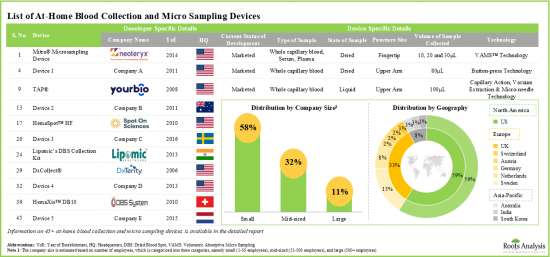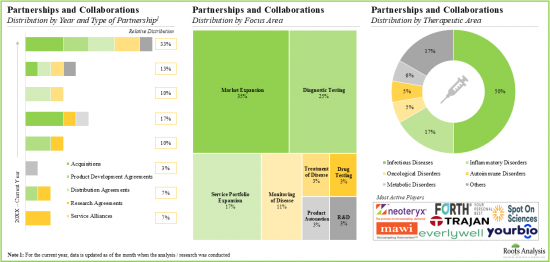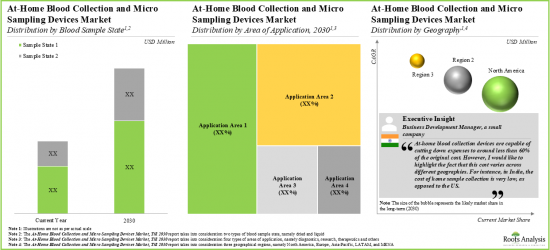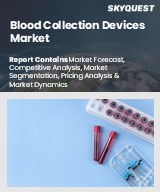
|
시장보고서
상품코드
1771300
세계의 가정용 채혈 기기 시장 : 업계 동향 및 예측 - 혈액 샘플 상태별, 샘플 채취 방법별, 기기 사용법별, 용도 분야별, 주요 지역별At Home Blood Collection Devices Market: Industry Trends and Global Forecasts - Distribution by Type of Blood Sample State, Method of Sample Collection, Device Usage, Area of Application, and Key Geographical Regions |
||||||
세계의 가정용 채혈 기기 개요
세계의 가정용 채혈 기기 시장 규모는 현재 7억 4,700만 달러가 되고 있습니다. 이 시장은 예측 기간 동안 10.7%의 CAGR로 확대될 것으로 예측되고 있습니다.
시장 세분화는 시장 규모와 기회 분석을 다음 매개 변수로 구분합니다.
혈액 샘플 상태별
- 건조 혈액 샘플
- 액체 혈액 샘플
샘플 채취 방법별
- 핑거 스틱법
- 푸시 버튼법
기기 사용법별
- 단회 사용 기기
- 재사용 기기
용도 분야별
- 진단
- 조사
- 치료
- 기타
주요 지역별
- 북미
- 유럽
- 아시아태평양
- 라틴아메리카
- 중동 및 북아프리카
세계의 가정용 채혈 기기 : 성장 및 동향
과거에 있어서, 채혈은 침습적이고 시간이 걸렸고, 헬스케어의 전문가가 필요했습니다. 그러나 최근 가정에서의 채혈 방법은 급속히 진화하고 있습니다. 실제로 한 조사에 따르면 참가자의 69%가 자가채혈처럼 직접 채취한 샘플을 제공하는 선택지가 있다면 임상시험에 참여할 가능성이 높아진다고 응답했습니다. 그 결과, 재택 검사 키트의 수는 최근 몇 년간 증가하고 있습니다.

또한 COVID-19 시대에는 물리적 거리를 유지하고 감염 위험을 피하기 위해 치료 요건에 대한 수요가 증가하여 시료 채취 및 검사를 위해 검사 시설을 방문하는 환자 수가 줄어 듭니다. 그 결과, 이 분야의 여러 이해관계자가 환자가 집에서 원격으로 혈액 샘플을 채취할 수 있도록 하는 새로운 장치나 기술을 개발하게 되었습니다. 분자 검출 기술의 진보와 검사에 필요한 샘플량의 대폭적인 감소에 따라 소형 기기는 포인트 오브 케어 용도를 향해 진단 및 모니터링 플랫폼을 변혁하고 있습니다. 이 기술은 미량 샘플의 혈액을 채취하기 위해 잘 알려져 있습니다. 또한 이러한 기술은 침습성이 높고 분석에 편차가 보일 가능성이 있는 기존 샘플링 기술과 비교하여 보다 사용하기 쉽습니다.
세계의 가정용 채혈 기기 : 주요 인사이트
이 보고서는 세계 가정용 채혈 기기의 현재 상태를 파악하고 업계 내 잠재적 성장 기회를 확인합니다. 본 보고서의 주요 조사 결과는 다음과 같습니다.
- 현재, 50 근처의 가정용 채혈 및 마이크로 샘플링 장치가 이용 가능 및 개발중이며, 이 영역에 종사하는 기업의 대부분은 미국에 소재하는 신흥 기업 또는 소규모 기업입니다.
- 모세 혈관 전혈의 채취를 목적으로 한 가정용 장치의 대부분이 현재 판매되고 있어, 건조 혈액 스폿 카드의 제제에 사용되는 DBS 기술이 가장 인기 있는 플랫폼으로서 부상하고 있습니다.
- 최근, TAP(R)II 및 Tasso-M20 자기 채혈 장치가 유럽 위원회로부터 CE 마크의 승인을 받았습니다.
- 모든 유형의 혈액 샘플을 제공하는 기업의 예로는(알파벳순으로) DBS System, Neoteryx, Sandstone Diagnostics, Sedia Biosciences 등이 있습니다.
- 경쟁 우위를 얻기 위해 이해 관계자는 적극적으로 제품 포트폴리오를 확대하고 고급 기능을 통합하여 기기를 업그레이드하고 있습니다.
- 이해관계자의 관심의 고조는 최근의 제휴 활동의 활성화에도 반영되고 있어, 지금까지 체결된 거래의 상당한 비율이 시장 확대에 초점을 맞춘 것이었습니다.

- 수년에 걸쳐 채혈 장치 관련 지적 재산은 눈부신 페이스로 성장하고 있으며, 특허의 대부분은 업계 진출기업에 의해 출원되고 있습니다.
- 이 영역에서 출원 및 부여된 특허수는 CAGR 11%로 증가하고 있으며, 2019년에 출원 및 부여된 특허수가 최대입니다.
- 고가의 특허는 샘플 수집, 안정화, 보존을 위한 시스템 및 방법을 포함한 혈액 샘플 관리에 중점을 둡니다.
- 대부분의 특허는 북미에서 출원 및 부여되어 있으며, 이 지역에서는 90% 이상의 특허가 업계 진출기업에 의해 출원되고 있습니다.
- 이 분야에서의 지속적인 기술 혁신을 지원하기 위해 민간 및 공적 투자자는 다양한 업계 이해관계자가 실시하는 대처에 대해 6억 5,000만 달러 상당의 대규모 자본 투자를 실시했습니다.
- 이 분야에서의 자금 조달 및 투자 활동은 CAGR 12%로 증가하고 있습니다. 투자 총액의 상당한 비율이 지난 2년간 행해진 것입니다.
- 대기업 외에도 일부 중견 및 중소기업이 IPO, 벤처 캐피탈 및 기타 주식을 통해 자금을 조달했습니다.

- COVID-19 팬데믹 사이에 가정용 채혈 및 마이크로 샘플링 장치의 채용이 호의적으로 증가한 것을 감안하면, 시장은 예측되는 장래에 있어서 큰 성장을 나타낼 것으로 예측됩니다.
가정용 채혈 기기의 주요 진출기업
- EUROIMMUN
- Everlywell
- Labcorp
- Labonovum
- Lameditech
- Quest Diagnostics
- Spot On Sciences
- Tasso
- Weavr Health
- YourBio Health
본 보고서에서는 세계의 가정용 채혈 기기 시장에 대해 조사했으며, 시장 개요와 함께, 혈액 샘플 상태별, 샘플 채취 방법별, 기기 사용법별, 용도 분야별 동향, 지역별 동향, 시장 진출기업 프로파일 등의 정보를 제공합니다.
목차
제1장 서문
제2장 주요 요약
제3장 서문
- 장의 개요
- 재택 혈액 채취 및 미량 샘플 채취 장치의 개요
- 혈액 샘플 채취 및 검사 용도
- 혈액 샘플 유형
- 재택 채혈의 장점
- 재택 채혈에 사용되는 방법
- 재택 혈액 채취 및 미량 혈액 샘플 채취 장치의 유형
- 장래의 전망
제4장 시장 개요
- 장의 개요
- 재택 혈액 채취 및 미량 샘플 채취 기기 : 시장 상황
- 재택 혈액 채취 및 미량 샘플 채취 기기 : 개발 기업 일람
- 가장 활발한 진출기업 : 제품 수별
제5장 제품 경쟁력 분석
- 장의 개요
- 전제 및 주요 입력 파라미터
- 조사 방법
제6장 기업 프로파일
- 장의 개요
- EUROIMMUN
- Everlywell
- Labcorp
- Labonovum
- Lameditech
- Quest Diagnostics
- Spot On Sciences
- Tasso
- Weavr Health
- YourBio Health
제7장 특허 분석
- 장의 개요
- 재택 혈액 채취 및 미량 샘플 채취 기기 : 특허 분석
제8장 파트너십
- 장의 개요
- 파트너십 모델
- 재택 혈액 채취 및 미량 샘플 채취 기기 : 제휴처 일람
제9장 자금 조달 및 투자 분석
- 장의 개요
- 자금 조달의 유형
- 재택 혈액 채취 및 미량 샘플 채취 기기 : 자금 조달 및 투자 분석
- 결론
제10장 비용 절감 분석
- 장의 개요
- 주요 전제
- 조사 방법
- 재택 혈액 채취 및 미량 샘플 채취 기기별 전체적인 비용 절감의 가능성
- 결론
제11장 시장 예측
- 장의 개요
- 예측 조사 방법 및 전제
- 재택 혈액 채취 및 미량 샘플 채취 기기 세계 시장(-2035년)
- 재택 혈액 채취 및 미량 샘플 채취 기기 시장(-2035년) : 혈액 샘플 상태별
- 재택 혈액 채취 및 미량 샘플 채취 기기 시장(-2035년) : 샘플 채취 방법별
- 재택 혈액 채취 및 미량 샘플 채취 기기 시장(-2035년) : 기기 사용법별
- 재택 혈액 채취 및 미량 샘플 채취 기기 시장(-2035년) : 용도 분야별
- 재택 혈액 채취 및 미량 샘플 채취 기기 시장(-2035년) : 지역별
제12장 결론
제13장 주요 인사이트
제14장 부록 I : 표 형식 데이터
제15장 부록 II : 기업 및 조직 목록
AJY 25.07.21GLOBAL AT HOME BLOOD COLLECTION DEVICES: OVERVIEW
As per Roots Analysis, the global at home blood collection devices valued at USD 747 million in the current year is anticipated to grow at a CAGR of 10.7% during the forecast period.
The market sizing and opportunity analysis has been segmented across the following parameters:
Type of Blood Sample State
- Dried Blood Sample
- Liquid Blood Sample
Method of Sample Collection
- Fingerstick Method
- Push-Button Method
Device Usage
- Single-use Devices
- Reusable Devices
Area of Application
- Diagnostics
- Research
- Therapeutics
- Other Areas of Applications
Key Geographical Regions
- North America
- Europe
- Asia Pacific
- Latin America
- Middle East and North Africa
GLOBAL AT HOME BLOOD COLLECTION DEVICES: GROWTH AND TRENDS
Notably, in the past, approaches used for blood collection were invasive, time consuming and required a healthcare expert. However, in recent years, the methods for blood collection at home have evolved at a rapid pace. In fact, according to a research study, 69% of participants indicated that they would more likely participate in clinical trials if they had the option to provide self-collected samples like self-blood collection. Consequently, the number of at home testing kits have increased in the last few years.

Further, in the COVID-19 era, the demand for point of care treatment had increased to support physical distancing and avoid risk of infections, thus leading to a decline in number of patients visiting laboratories for sample collection and testing. Consequently, it encouraged several stakeholders in the domain to develop novel devices and technologies that can enable patients to collect blood samples remotely at home. With the advancements in molecular detection techniques and a significant reduction in the amount of sample required for testing, miniature devices are transforming diagnostic and monitoring platforms toward point-of-care applications. This technique is well known for capturing minute samples of blood. Moreover, these techniques are more user friendly, as compared to traditional sampling techniques which are highly invasive and may show variation in analysis.
GLOBAL AT HOME BLOOD COLLECTION DEVICES: KEY INSIGHTS
The report delves into the current state of global at home blood collection devices and identifies potential growth opportunities within the industry. Some key findings from the report include:
- Presently, close to 50 at-home blood collection and micro sampling devices are available / being developed; majority of the firms engaged in this domain are startups or small companies located in the US.
- Most of the at-home devices intended for collection of whole capillary blood are presently marketed; DBS technology, used for preparation of dried blood spot cards, has emerged as the most popular platform.
- Recently, TAP(R) II and Tasso-M20 self-blood collecting devices received CE mark approval from the European Commission.
- Examples of companies offering all types of blood samples include (in alphabetical order) DBS System, Neoteryx, Sandstone Diagnostics and Sedia Biosciences.
- In pursuit of gaining a competitive edge, stakeholders are actively expanding their product portfolios and upgrading their devices, via incorporation of advanced features.
- The growing interest of the stakeholders is also reflected from the recent rise in partnership activity; a significant proportion of the deals inked till date were focused on market expansion.

- Over the years, the intellectual property related to blood collection devices has grown at a commendable pace, with majority of the patents being filed by industry players.
- Number of patents filed / granted in this domain have increased at a CAGR of 11%, with maximum number of patents filed / granted in 2019.
- The high value patents focus on blood sample management, including systems and methods for sample collection, stabilization and preservation.
- Most of the patents were filed / granted in North America; in this region, more than 90% patents were filed by the industry players.
- To support the ongoing innovation in this domain, private and public investors have made substantial capital investments, worth ~USD 650 million, in initiatives undertaken by various industry stakeholders.
- Funding and investment activity in this domain has increased at a CAGR of 12%. A significant proportion of the total investment was made in the last two years.
- In addition to large players, several mid-sized and small companies have raised funds through IPO, venture capitals and other equity.

- Given the favourable increase in adoption of at-home blood collection and micro sampling devices during the COVID-19 pandemic, the market is anticipated to witness significant growth in the foreseen future.
Example Players in the At Home Blood Collection Devices
- EUROIMMUN
- Everlywell
- Labcorp
- Labonovum
- Lameditech
- Quest Diagnostics
- Spot On Sciences
- Tasso
- Weavr Health
- YourBio Health
GLOBAL AT HOME BLOOD COLLECTION DEVICES: RESEARCH COVERAGE
- Market Sizing and Opportunity Analysis: The report features an in-depth analysis of the global antiviral drugs market, focusing on key market segments, including [A] type of blood sample state, [B] method of sample collection, [C] device usage, [D] area of application and [E] key geographical regions.
- Market Landscape: A comprehensive evaluation of at-home self-blood collection and micro sampling devices, considering various parameters, such as [A] device class, [B] current status of development, [C] regulatory approvals / certifications received, [D] type of technology, [E] device usage, [F] type of sample, [G] blood sample state, [H] volume of sample collected, [I] puncture site, [J] method of sample collection, [K] storage temperature and [L] application area. Additionally, a comprehensive evaluation of the companies engaged in the development of at home blood collection and micro sampling devices, considering various parameters, such as [A] year of establishment, [B] company size, [C] location of headquarters and [D] most active players (in terms of number of devices).
- Company Profiles: In-depth profiles of companies engaged in at home blood collection devices market, focusing on [A] company overviews, [B] product portfolio and [C] recent developments and an informed future outlook.
- Product Competitiveness Analysis: A comprehensive competitive analysis of at home blood collection and micro sampling devices, examining factors, such as [A] supplier power and [B] key product-related specifications.
- Patent Analysis: An in-depth analysis of patents filed / granted till date in the at home blood collection devices domain, based on various relevant parameters, such as [A] type of patent, [B] publication year, [C] application year, [D] regional applicability, [E] CPC symbols, [F] emerging focus areas, [G] most active players (in terms of the number of patents filed / granted) and [H] patent valuation.
- Partnerships and Collaborations: An insightful analysis of the deals inked by stakeholders in the global at home blood collection devices market, based on several parameters, such as [A] year of partnership, [B] type of partnership model adopted, [C] focus area, [D] therapeutic area and [E] regional distribution.
- Funding and Investments: An in-depth analysis of the fundings received by players in at home blood collection devices market, based on relevant parameters, such as [A] year of investment, [B] number of funding instances, [C] amount invested, [D] type of funding, [E] most active players (in terms of number of funding instances and amount raised), [F] most active investors (in terms of number of funding instances), [G] geographical distribution, [H] purpose of investment and [I] application area.
- Cost Saving Analysis: A comprehensive analysis of cost saving potential associated with the use of at-home self-blood collection and micro sampling devices examining various factors.
KEY QUESTIONS ANSWERED IN THIS REPORT
- How many companies are currently engaged in this market?
- Which are the leading companies in this market?
- What factors are likely to influence the evolution of this market?
- What is the current and future market size?
- What is the CAGR of this market?
- How is the current and future market opportunity likely to be distributed across key market segments?
REASONS TO BUY THIS REPORT
- The report provides a comprehensive market analysis, offering detailed revenue projections of the overall market and its specific sub-segments. This information is valuable to both established market leaders and emerging entrants.
- Stakeholders can leverage the report to gain a deeper understanding of the competitive dynamics within the market. By analyzing the competitive landscape, businesses can make informed decisions to optimize their market positioning and develop effective go-to-market strategies.
- The report offers stakeholders a comprehensive overview of the market, including key drivers, barriers, opportunities, and challenges. This information empowers stakeholders to stay abreast of market trends and make data-driven decisions to capitalize on growth prospects.
ADDITIONAL BENEFITS
- Complimentary PPT Insights Packs
- Complimentary Excel Data Packs for all Analytical Modules in the Report
- 15% Free Content Customization
- Detailed Report Walkthrough Session with Research Team
- Free Updated report if the report is 6-12 months old or older
TABLE OF CONTENTS
1. PREFACE
- 1.1. Scope of the Report
- 1.2. Research Methodology
- 1.2.1. Research Assumptions
- 1.2.2. Project Methodology
- 1.2.3. Forecast Methodology
- 1.2.4. Robust Quality Control
- 1.2.5. Key Considerations
- 1.2.5.1. Demographics
- 1.2.5.2. Economic Factors
- 1.2.5.3. Government Regulations
- 1.2.5.4. Supply Chain
- 1.2.5.5. COVID Impact / Related Factors
- 1.2.5.6. Market Access
- 1.2.5.7. Healthcare Policies
- 1.2.5.8. Industry Consolidation
- 1.3 Key Questions Answered
- 1.4. Chapter Outlines
2. EXECUTIVE SUMMARY
3. INTRODUCTION
- 3.1. Chapter Overview
- 3.2. Overview of At-Home Blood Collection and Micro Sampling Devices
- 3.3. Applications of Blood Sampling and Testing
- 3.3.1. Complete Blood Count
- 3.3.2. Basic Metabolic Panel
- 3.3.3. Lipoprotein Panel
- 3.4. Types of Blood Sampling
- 3.4.1. Dried Blood Sampling
- 3.4.2. Wet Blood Sampling
- 3.5. Benefits of At-Home Blood Collection
- 3.6. Methods Used for At-Home Blood Collection
- 3.6.1. Fingerstick Method
- 3.6.2. Press Button Method
- 3.6.3. Heel-stick Method
- 3.7. Types of At-Home Blood Collection and Micro Sampling Devices
- 3.7.1. Dried Blood Spot Collection Kits
- 3.7.2. Microtainer Tubes
- 3.8. Future Perspectives
4. MARKET OVERVIEW
- 4.1. Chapter Overview
- 4.2. At-Home Blood Collection and Micro Sampling Devices: Overall Market Landscape
- 4.2.1. Analysis by Device Class
- 4.2.2. Analysis by Current Status of Development
- 4.2.3. Analysis by Regulatory Approvals / Certifications Received
- 4.2.4. Analysis by Type of Technology
- 4.2.5. Analysis by Device Usage
- 4.2.6. Analysis by Type of Sample
- 4.2.7. Analysis by Blood Sample State
- 4.2.8. Analysis by Volume of Sample Collected
- 4.2.9. Analysis by Puncture Site
- 4.2.10. Analysis by Method of Sample Collection
- 4.2.11. Analysis by Storage Temperature
- 4.2.12. Analysis by Application Area
- 4.3. At-Home Blood Collection and Micro Sampling Devices: List of Developers
- 4.3.1. Analysis by Year of Establishment
- 4.3.2. Analysis by Company Size
- 4.3.3. Analysis by Geography
- 4.3.4. Analysis by Year of Establishment, Company Size and Location of Headquarters
- 4.4. Most Active Players: Analysis by Number of Products
5. PRODUCT COMPETITIVENESS ANALYSIS
- 5.1. Chapter Overview
- 5.2. Assumptions and Key Input Parameters
- 5.3. Methodology
- 5.3.1. Product Competitiveness Analysis: North America
- 5.3.2. Product Competitiveness Analysis: Europe
- 5.3.3. Product Competitiveness Analysis: Asia-Pacific
6. COMPANY PROFILES
- 6.1. Chapter Overview
- 6.2. EUROIMMUN
- 6.2.1. Company Overview
- 6.2.2. Product Portfolio
- 6.2.3. Recent Developments and Future Outlook
- 6.3. Everlywell
- 6.3.1. Company Overview
- 6.3.2. Product Portfolio
- 6.3.3. Recent Developments and Future Outlook
- 6.4. Labcorp
- 6.4.1. Company Overview
- 6.4.2. Product Portfolio
- 6.4.3. Recent Developments and Future Outlook
- 6.5. Labonovum
- 6.5.1. Company Overview
- 6.5.2. Product Portfolio
- 6.5.3. Recent Developments and Future Outlook
- 6.6. Lameditech
- 6.6.1. Company Overview
- 6.6.2. Product Portfolio
- 6.6.3. Recent Developments and Future Outlook
- 6.7. Quest Diagnostics
- 6.7.1. Company Overview
- 6.7.2. Product Portfolio
- 6.7.3. Recent Developments and Future Outlook
- 6.8. Spot On Sciences
- 6.8.1. Company Overview
- 6.8.2. Product Portfolio
- 6.8.3. Recent Developments and Future Outlook
- 6.9. Tasso
- 6.9.1. Company Overview
- 6.9.2. Product Portfolio
- 6.9.3. Recent Developments and Future Outlook
- 6.10. Weavr Health
- 6.10.1. Company Overview
- 6.10.2. Product Portfolio
- 6.10.3. Recent Developments and Future Outlook
- 6.11. YourBio Health
- 6.11.1. Company Overview
- 6.11.2. Product Portfolio
- 6.11.3. Recent Developments and Future Outlook
7. PATENT ANALYSIS
- 7.1. Chapter Overview
- 7.2. At-Home Blood Collection and Micro Sampling Devices: Patent Analysis
- 7.2.1. Scope and Methodology
- 7.2.2. Analysis by Publication Year
- 7.2.3. Analysis by Publication Year and Type of Patent
- 7.2.4. Analysis by Geography
- 7.2.5. Analysis by CPC Symbols
- 7.2.6. Analysis by Emerging Focus Area
- 7.2.7. Most Active Players: Analysis by Number of Patents
- 7.2.8. Patent Benchmarking Analysis
- 7.2.9. Patent Valuation Analysis
- 7.2.10. Overall Intellectual Property Portfolio: Analysis by Type of Organization
8. PARTNERSHIPS
- 8.1. Chapter Overview
- 8.2. Partnership Models
- 8.3. At-Home Blood Collection and Micro Sampling Devices: List of Partnerships
- 8.3.1. Analysis by Year of Partnership
- 8.3.2. Analysis by Type of Partnership
- 8.3.3. Analysis by Year and Type of Partnership
- 8.3.4. Analysis by Focus Area
- 8.3.5. Analysis by Year of Partnership and Focus Area
- 8.3.6. Analysis by Type of Partnership and Focus Area
- 8.3.7. Analysis by Therapeutic Area
- 8.3.8. Analysis by Region
- 8.3.8.1. Continent-wise Distribution
- 8.3.8.2. Intercontinental and Intracontinental Distribution
- 8.3.8.3. Country-wise Distribution
- 8.3.9. Most Active Players: Analysis by Number of Partnerships
9. FUNDING AND INVESTMENT ANALYSIS
- 9.1. Chapter Overview
- 9.2. Types of Funding
- 9.3. At-Home Blood Collection and Micro Sampling Devices: Funding and Investment Analysis
- 9.3.1. Analysis of Number of Funding Instances by Year
- 9.3.2. Analysis by Amount Invested
- 9.3.3. Analysis by Type of Funding
- 9.3.4. Analysis by Year and Type of Funding
- 9.3.5. Analysis of Amount Invested by Geography
- 9.3.6. Most Active Players: Analysis by Number of Funding Instances and Amount Invested
- 9.3.7. Key Investors: Analysis by Number of Funding Instances
- 9.3.8. Analysis by Purpose of Investment
- 9.3.9. Analysis by Application Area
- 9.4. Concluding Remarks
10. COST SAVING ANALYSIS
- 10.1. Chapter Overview
- 10.2. Key Assumptions
- 10.3. Methodology
- 10.4. Overall Cost Saving Potential of At-Home Blood Collection and Micro Sampling Devices
- 10.5. Concluding Remarks
11. MARKET FORECAST
- 11.1. Chapter Overview
- 11.2. Forecast Methodology and Assumptions
- 11.3. Global At-Home Blood Collection and Micro Sampling Devices Market, Till 2035
- 11.3.1. At-Home Blood Collection and Micro Sampling Devices Market, Till 2035: Analysis by Blood Sample State
- 11.3.1.1. At-Home Blood Collection and Micro Sampling Devices Market for Dried Blood Samples, Till 2035
- 11.3.1.2. At-Home Blood Collection and Micro Sampling Devices Market for Liquid Blood Samples, Till 2035
- 11.3.2. At-Home Blood Collection and Micro Sampling Devices Market, Till 2035: Analysis by Method of Sample Collection
- 11.3.2.1. At-Home Blood Collection and Micro Sampling Devices Market for Fingerstick Method of Sample Collection, Till 2035
- 11.3.2.2. At-Home Blood Collection and Micro Sampling Devices Market for Push-Button Method of Sample Collection, Till 2035
- 11.3.3. At-Home Blood Collection and Micro Sampling Devices Market, Till 2035: Analysis by Device Usage
- 11.3.3.1. At-Home Blood Collection and Micro Sampling Devices Market for Single-use Devices, Till 2035
- 11.3.3.2. At-Home Blood Collection and Micro Sampling Devices Market for Reusable Devices, Till 2035
- 11.3.4. At-Home Blood Collection and Micro Sampling Devices Market, Till 2035: Analysis by Area of Application
- 11.3.4.1. At-Home Blood Collection and Micro Sampling Device Market for Diagnostics, Till 2035
- 11.3.4.2. At-Home Blood Collection and Micro Sampling Device Market for Research, Till 2035
- 11.3.4.3. At-Home Blood Collection and Micro Sampling Device Market for Therapeutics, Till 2035
- 11.3.4.4. At-Home Blood Collection and Micro Sampling Device Market for Other Areas of Application, Till 2035
- 11.3.5. At-Home Blood Collection and Micro Sampling Devices Market, Till 2035: Analysis by Region
- 11.3.5.1. At-Home Blood Collection and Micro Sampling Devices Market in North America, Till 2035
- 11.3.5.2. At-Home Blood Collection and Micro Sampling Devices Market in Europe, Till 2035
- 11.3.5.3. At-Home Blood Collection and Micro Sampling Devices Market in Asia-Pacific, Till 2035
- 11.3.5.4. At-Home Blood Collection and Micro Sampling Devices Market in Latin America, Till 2035
- 11.3.5.5. At-Home Blood Collection and Micro Sampling Devices Market in MENA, Till 2035
- 11.3.1. At-Home Blood Collection and Micro Sampling Devices Market, Till 2035: Analysis by Blood Sample State
12. CONCLUSION
13. EXECUTIVE INSIGHTS
- 13.1. Chapter Overview
- 13.2. Interview Transcript, Business Development Manager, Company A



















